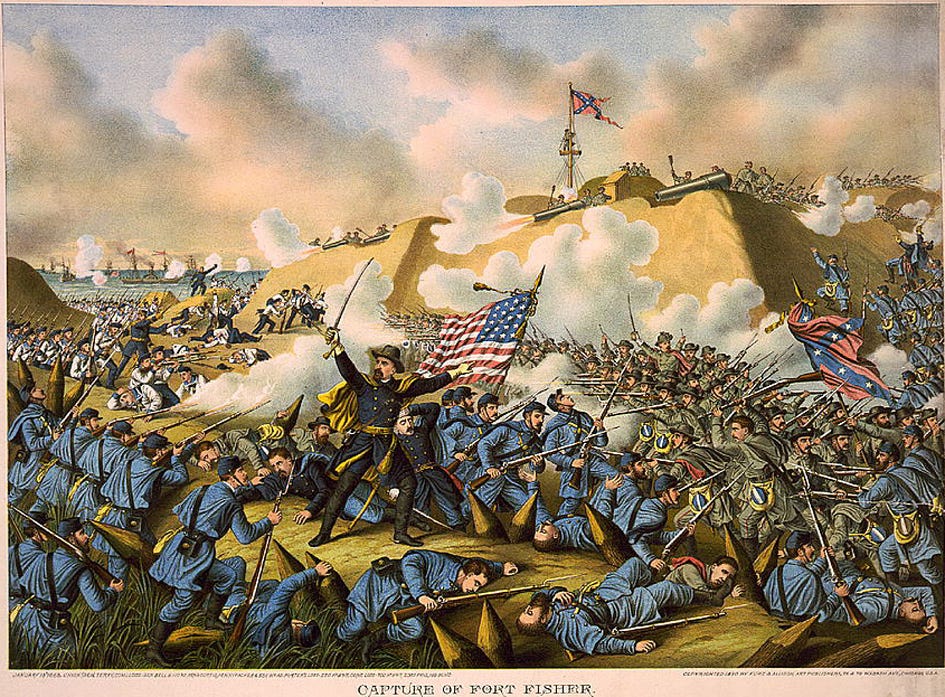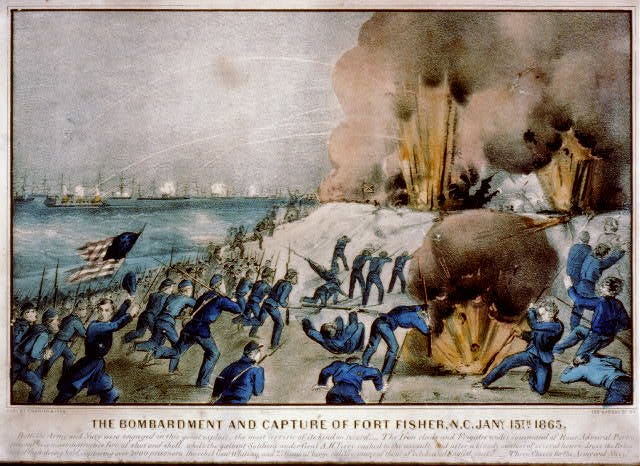Today in Strategic History!
13 January 1865 - "The Second Battle of Ft. Fisher" Multi-Domain Ops (Civil War)
On January 13, 1865, as the American Civil War entered its final months, a momentous military operation began to unfold on the shores of North Carolina. The target was Fort Fisher, a formidable Confederate stronghold that guarded the vital port of Wilmington. This operation would prove to be a turning point in the war, showcasing innovative tactics and the largest amphibious assault in U.S. history up to that time. As dawn broke, the horizon was filled with an awe-inspiring sight. A massive armada of Union ships, described by Colonel William Lamb as "the most formidable armada the world had ever known," appeared off the coast. The fleet comprised 58 warships, bristling with over 600 guns, accompanied by transports carrying some 8,500 troops.
The operation began with a meticulously planned naval bombardment. Unlike the previous failed attempt in December, this assault was calculated and precise. The Union ships unleashed a storm of fire upon Fort Fisher, their shells raining down with such intensity that the very earth trembled beneath the defenders' feet.
This relentless barrage was designed to soften the fort's defenses and pave the way for the ground assault. As the bombardment continued, Union troops began their amphibious landing on Federal Point. In a notable display of the changing face of warfare, 40% of the attacking force consisted of United States Colored Troops (USCTs), freed African Americans who now fought for the Union cause.
Their presence underscored the evolving nature of the conflict and its implications for American society. The landing itself was a complex and daring maneuver. Thousands of soldiers poured ashore, establishing a beachhead north of Fort Fisher.
This amphibious operation, involving close coordination between naval and land forces, was a relatively new concept at the time and would influence military tactics for generations to come
As the troops secured their positions, a division of USCTs advanced northward up the peninsula. Their mission was crucial: to establish a blocking position and prevent Confederate reinforcements from coming to the fort's aid.
This strategic deployment demonstrated the Union's comprehensive approach to the assault. The scene was set for a decisive battle. The defenders of Fort Fisher, though outnumbered, were determined to hold their ground. They knew that the fate of Wilmington, the Confederacy's last major Atlantic port, hung in the balance.
The stage was set for three days of intense combat that would test the mettle of both sides and ultimately shape the final months of the Civil War. As night fell on January 13, the Union forces prepared for the challenges that lay ahead. The bombardment would continue, and on January 15, they would launch their final assault on the fort. The innovative tactics employed in this operation—the combined naval and land assault, the use of ironclad ships, and the strategic deployment of troops—would prove instrumental in securing a Union victory and hastening the end of the war.
This event showcased issues that still are considered when conducting operational and strategic planning. Planners and leaders must consider the grammar of the multiple domains that are in play in the conflict. Incorporating flexibility in moving from domain to domain is a key to success in any operation.




